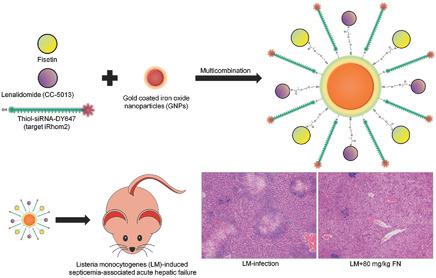当前位置:
X-MOL 学术
›
Adv. Healthcare Mater.
›
论文详情
Our official English website, www.x-mol.net, welcomes your
feedback! (Note: you will need to create a separate account there.)
Multicombination Approach Suppresses Listeria monocytogenes‐Induced Septicemia‐Associated Acute Hepatic Failure: The Role of iRhom2 Signaling
Advanced Healthcare Materials ( IF 10.0 ) Pub Date : 2018-06-26 , DOI: 10.1002/adhm.201800427 Min-Xuan Xu 1, 2 , Chen-Xu Ge 1, 2 , Yu-Ting Qin 3 , Ting-Ting Gu 4 , De-Shuai Lou 1, 2 , Qiang Li 1, 2 , Lin-Feng Hu 1, 2 , Jun Tan 1, 2
Advanced Healthcare Materials ( IF 10.0 ) Pub Date : 2018-06-26 , DOI: 10.1002/adhm.201800427 Min-Xuan Xu 1, 2 , Chen-Xu Ge 1, 2 , Yu-Ting Qin 3 , Ting-Ting Gu 4 , De-Shuai Lou 1, 2 , Qiang Li 1, 2 , Lin-Feng Hu 1, 2 , Jun Tan 1, 2
Affiliation

|
The mortality rate of acute liver failure significantly increases due to fatal septicemia. Inactive rhomboid protein 2 (iRhom2) is an essential regulator of shedding TNF‐α by trafficking with TNF‐α converting enzyme (TACE). Fisetin, a flavonoid present in various fruits and plants, possesses anti‐oxidative stress and anti‐inflammatory activities. Here, multi‐combination nanoparticles Fe@Au conjugated with fisetin, iRhom2 small interfering RNA (siRNA), and TNF‐α inhibitor (FN) are prepared to examine their effects on fatal septicemia‐associated hepatic failure induced by Listeria monocytogenes (LM) in mice and to reveal the underlying mechanisms. After LM infection, upregulation of glutamic‐oxalacetic transaminease, glutamic‐pyruvic transaminase, alkaline phosphatase, TNF‐α, malondialdehyde, H2O2, and O2‐ is observedcompared to FN‐treated mice. The iRhom2/TACE/TNF‐α signals are enhanced in vivo and in vitro, resulting in oxidative stress, which is especially associated with the activation of kupffer cells and other macrophages. Decrease in Nrf2 activation and increase of inflammation‐associated regulators are also noted in vivo and in vitro. Furthermore, overexpression of TNF‐α derived from macrophages aggravates hepatic failure. Inversely, the processes above are restored by FN nanoparticles through the regulation of the iRhom2/TACE/TNF‐α axis and Nrf2 activation. These findings suggest that FN may be a potential approach to protect against bacterial septicemia‐related diseases by targeting iRhom2.
中文翻译:

多种组合方法抑制单核细胞增多性李斯特菌诱导的败血病相关的急性肝衰竭:iRhom2信号传导的作用
由于致命败血症,急性肝衰竭的死亡率显着增加。失活的菱形蛋白2(iRhom2)是通过与TNF-α转化酶(TACE)交易而脱落TNF-α的重要调节剂。Fisetin是多种水果和植物中存在的类黄酮,具有抗氧化应激和抗炎活性。在这里,制备了多组合纳米粒子Fe @ Au与fisetin,iRhom2小干扰RNA(siRNA)和TNF-α抑制剂(FN)偶联,以检查它们对单核细胞增生性李斯特菌(LM)诱导的致命败血病相关性肝衰竭的影响。并揭示小鼠的潜在机制。LM感染后,谷氨酸-草酰乙酸转氨酶,谷氨酸-丙酮酸转氨酶,碱性磷酸酶,TNF-α,丙二醛,H 2 O 2上调和O 2 -被observedcompared到FN处理的小鼠。iRhom2 / TACE /TNF-α信号在体内和体外均得到增强,导致氧化应激,这尤其与枯否细胞和其他巨噬细胞的激活有关。在体内和体外也发现Nrf2激活的减少和炎症相关调节剂的增加。此外,巨噬细胞衍生的TNF-α的过度表达会加重肝功能衰竭。相反,FN纳米颗粒通过调节iRhom2 / TACE /TNF-α轴和Nrf2活化来恢复上述过程。这些发现表明,FN可能通过靶向iRhom2来预防细菌败血症相关疾病。
更新日期:2018-06-26
中文翻译:

多种组合方法抑制单核细胞增多性李斯特菌诱导的败血病相关的急性肝衰竭:iRhom2信号传导的作用
由于致命败血症,急性肝衰竭的死亡率显着增加。失活的菱形蛋白2(iRhom2)是通过与TNF-α转化酶(TACE)交易而脱落TNF-α的重要调节剂。Fisetin是多种水果和植物中存在的类黄酮,具有抗氧化应激和抗炎活性。在这里,制备了多组合纳米粒子Fe @ Au与fisetin,iRhom2小干扰RNA(siRNA)和TNF-α抑制剂(FN)偶联,以检查它们对单核细胞增生性李斯特菌(LM)诱导的致命败血病相关性肝衰竭的影响。并揭示小鼠的潜在机制。LM感染后,谷氨酸-草酰乙酸转氨酶,谷氨酸-丙酮酸转氨酶,碱性磷酸酶,TNF-α,丙二醛,H 2 O 2上调和O 2 -被observedcompared到FN处理的小鼠。iRhom2 / TACE /TNF-α信号在体内和体外均得到增强,导致氧化应激,这尤其与枯否细胞和其他巨噬细胞的激活有关。在体内和体外也发现Nrf2激活的减少和炎症相关调节剂的增加。此外,巨噬细胞衍生的TNF-α的过度表达会加重肝功能衰竭。相反,FN纳米颗粒通过调节iRhom2 / TACE /TNF-α轴和Nrf2活化来恢复上述过程。这些发现表明,FN可能通过靶向iRhom2来预防细菌败血症相关疾病。











































 京公网安备 11010802027423号
京公网安备 11010802027423号